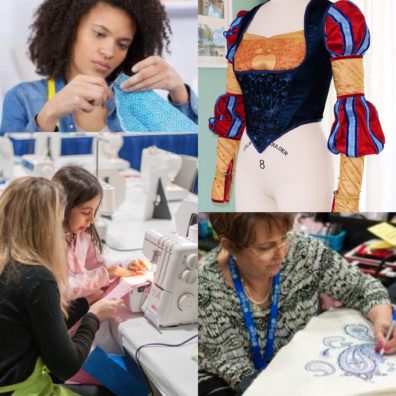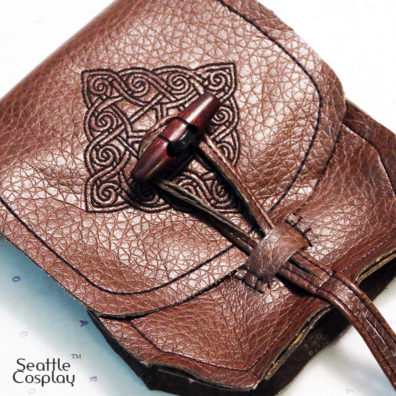
An Easy-to-Sew Fashion Star
The humble yet classic kimono is a huge star in current fashion and its popularity is on the rise. Seen on the runways as well as in the grocery store aisles, it’s a versatile garment that can be worn by almost everyone. The kimono’s comfortable yet simple shape holds so much possibility within it’s easy fitting lines that easily lend themselves to every occasion from holiday to casual. Today’s fun, quick to make kimonos are the perfect canvas for beautiful fabrics and embellished designs. Perfect for those of us who love to sew our own handmade wardrobe!
If you’ve never made or worn a kimono or decided they’re not for you, keep reading. I’ve developed an obsessive Kimono addiction that I’d love to share with you! A basic kimono can be cut, sewn, and ready to wear in four hours or less making it an excellent choice for a last minute garment! Most kimono patterns consist of just three basic pieces: front, back, and sleeves. They may be finished with bands around the neck, front, and sleeves or facings. Every handmade wardrobe should contain a comfy kimono – or two – or five!

An Adaptable Shape for Everyone
If a Kimono has always seemed like just too much fabric for your comfort level, consider fit and length. To avoid the boxy sharp rectangles, look for a kimono designed with a slight curve under the arm. My favorite is the Florence Kimono from independent pattern company, Sew Caroline. Florence has a gently shaped underarm curve that makes all the difference in its flow and fit. It removes the boxiness while maintaining the traditional shape and creates a kimono that is wearable for most of us.
When choosing your kimono pattern size, consider how much ease you are comfortable with in a “jacket” or “cardigan”. If you don’t care for lots of drapey fabric on your body style, you may want to make a smaller size than normal. If you’d like more drape, go up a size.
Think about your favorite finished length, too. Kimonos can be waist, hip, or knee length, or even longer. With your fabric choice in mind, consider the sleeve length that will be most flattering for you. For a super-quick Spring or Summer sew, leave the sleeves off so your kimono can easily be thrown on over a t-shirt or swimsuit.

A Buffet of Fabric and Embellishment Choices
The rectangular pieces used to create the traditional t-shaped Kimono were originally designed for 14” – 16” Yukata fabrics. Light to medium weight fabrics like silk, rayon, chambray, linen, cotton, tencel, velvet, lace, knits and sweatering are all fabulous choices for today’s kimonos. The simple shape is also perfect for maintaining the integrity of a large print or other fabric you “can’t stand to cut into”. The large pieces that make up a kimono will compliment your fabric’s design and show off the print, stripe, or weave beautifully!
Kimonos are and amazing canvas for embroidery, applique, beading and all forms of embellishment. Use your creative skills to add interest to the back, front, or both. Embellish the front and sleeve bands with applique or pieced fabrics. Add lace or machine embroidery to the shoulders for a surprising pop of gorgeousness. And, don’t forget the edges – they’re perfect for fringe. Whatever you choose, you’ll make a unique statement of your own talent and fashion style!

Unlimited Wearable Options
Don’t feel limited by the traditional styling of your kimono. There are SO many options! Think of it as you would any other jacket or cardigan when you’re putting together different looks. Try these styles with your Kimono:
- Top a Summer tank and skirt or shorts with a kimono and add your favorite sandals.
- Carry your kimono to the beach for a swimsuit cover-up with instant style.
- Go Boho with a long kimono worn over wide leg jeans, a t-shirt and a floppy hat.
- Add a kimono to your Summer dress or Winter LBD and create an ensemble.
- Change your kimono’s silhouette by adding a belt or tying the fronts in waist high knot.
- Dress up your kimono with stunning jewelry and add a cross-body bag for shopping trips.

Watch for Creative Inspiration
Although it’s often thought that we can’t save money sewing our own clothing, the kimonos shown on the Johnny Was web site will make you think differently. Ranging in price from $300 to $800, these simply shaped jackets are stitched from luxury fabrics and embellished with embroidery and applique. All things that are readily available to those of us who enjoy sewing our own handmade wardrobes and at a much lower price! While attending the Sewing & Stitchery Expo this year, plan time for a trip to Bellevue, WA to visit their store and collect loads of inspiration to recreate on your own!
I’ve been blogging about my journey into kimono obsession on my own blog, The Sewful Life. For more details about the kimonos I’ve made, hop over there and search for “Kimono” on the right hand side. You’ll find five blog posts about the kimonos I have known, sewn, and thoroughly love!
About the Author: Annette Millard recently started her own blog, The Sewful Life, which utilizes her sewing and teaching experience to provide helpful tips and tricks, tutorials, and project ideas. Visit the blog at sewfullife.com and be sure to say “hi” at Expo in one of her classes! View the class catalog to learn about the classes Annette will be teaching in 2019.














































